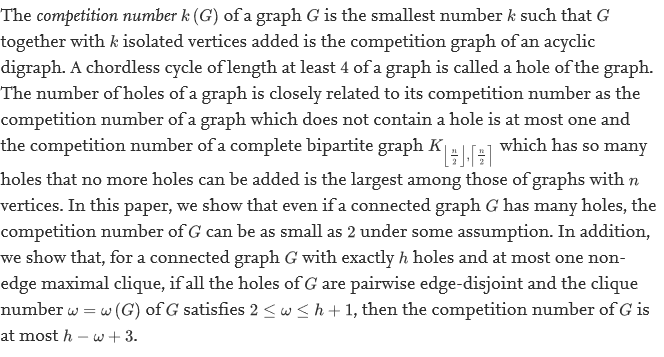논문
Graphs having many holes but with small competition numbers
JungYeun Lee; Suh-Ryung Kim; Seog-Jin Kim, Yoshio Sano | Applied Mathematics Letters 24 (2011)
Estimating network link weight from inverse phase synchronization
Won Sup Kim, Xue-Mei Cui, Chang No Yoon, Hung Xuan Ta and Seung Kee Han | EPL 96 (2011)
Zigzag Turning Preference of Freely Crawling Cells
Taeseok Daniel Yang; Jin-Sung Park ; Youngwoon Choi; Wonshik Choi,; Tae-Wook Ko; Kyoung J. Lee | PLoS One 6 (2011)
Numerical studies of the fingering phenomena for the thin film equation
Yibao Li, Hyun geun Lee, Daeki Yoon, Woonjae Hwang, Youngsoo Ha, Junseok Kim | International Journal for Numerical Methods in Fluids 67 (2011)
A New Ergonomic Interface System for the Disabled Person
Heo, Hwan; Lee, Ji-Woo; Lee, Won-Oh; Lee, Eui-Chul; Park, Kang-Ryoung | The Ergonomics Society of Korea 30 (2011)
Color Saturation Compensation in iCAM06 for High-Chroma HDR Imaging
Hwi-Gang KIM; Sung-Hak LEE; Tae-Wuk BAE; Kyu-Ik SOHNG | IEICE Trans. of Fundamentals of Electronics, Communications and Computer E94-A (2011)
Interactive emotional content communications system using portable wireless biofeedback device
Dong Keun Kim; Jonghwa Kim; Eui Chul Lee; Mincheol Whang; Yongjoo Cho | IEEE Transactions on Consumer Electronics 57 (2011)
New Computer Interface Combining Gaze Tracking and Brainwave Measurements
Jae Won Bang ; Eui Chul Lee ; Kang Ryoung Park | IEEE Transactions on Consumer Electronics 57 (2011)
Yongwoong Jeon; Chang S. Nam; Young-Joo Kim; Min Cheol Whang | "International Journal of 41 (2011)
Experimental Investigations of Pupil Accommodation Factors
Eui Chul Lee, Kang Ryoung Park, Ji Woo Lee | Investigative Ophthalmology & Visual Science 52 (2011)















